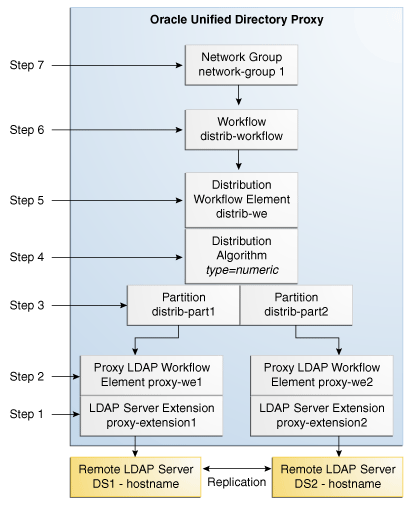| Skip Navigation Links | |
| Exit Print View | |

|
Oracle Fusion Middleware Deployment Planning Guide for Oracle Unified Directory 11g Release 1 (11.1.1) |
| Skip Navigation Links | |
| Exit Print View | |

|
Oracle Fusion Middleware Deployment Planning Guide for Oracle Unified Directory 11g Release 1 (11.1.1) |
1. Overview of Oracle Unified Directory
2. Overview of the Directory Server
3. Overview of the Proxy Server
4. Overview of the Replication Gateway
5. Building Blocks of the Proxy Server
6. Example Deployments Using the Directory Server
7. Example Deployments Using the Proxy Server
8. Simple Proxy Deployments Using the Command Line Interface
Configuring Load Balancing With the Command Line Interface
To Configure Simple Load Balancing
Configuring Distribution and Load Balancing
The following is a step by step procedure that defines all the different elements needed to set up a deployment using simple distribution. The following example shows a distribution split on two partitions. For more information on the different types of distribution available, see Data Distribution Using the Proxy.
The following figure illustrates all the objects that need to be created to configure a Oracle Unified Directory proxy using a simple distribution deployment. The objects must be created in the order indicated.

All the commands in this procedure specify the proxy hostname (-h), the proxy admin port (-p), the bind DN for the initial root user (-D) and the proxy password you want to configure (-w). You must also indicate the authentication; if none is indicated and the client and the server are running in the same instance, the local authentication configuration is used.
$ dsconfig -p 4444 -h localhost -D"cn=Directory Manager" -w password \ create-extension \ --extension-name proxy_extension1 \ --type ldap-server \ --set enabled:true \ --set remote-ldap-server-address:DS1_hostname \ --set remote-ldap-server-port:2389
The LDAP server extension is a link to the remote LDAP server. For this use case, you will need two remote LDAP server instances. Go through this step again, making sure to use a different LDAP hostname and port.
$ dsconfig -p 4444 -h localhost -D"cn=Directory Manager" -w password \ create-workflow-element \ --element-name proxy-we1 \ --type proxy-ldap\ --set enabled:true \ --set client-cred-mode:use-client-identity \ --set ldap-server-extension:proxy_extension1
You will need at least two remote LDAP servers for a distribution architecture. Go through this step again. The LDAP server extension name should be the same as those created in step 1.
The property client-cred-mode indicates the type of authentication used between the proxy and remote LDAP server. The client credential mode can be: use-client-identity, use-specific-identity, or use-proxy-auth.
$ dsconfig -p 4444 -h localhost -D"cn=Directory Manager" -w password \ create-workflow-element \ --element-name distrib-we \ --type distribution \ --set base-dn:dc=example,dc=com \ --set enabled:true
$ dsconfig -p 4444 -h localhost -D"cn=Directory Manager" -w password \ create-distribution-algorithm \ --element-name distrib-we \ --type numeric \ --set distribution-attribute:uid
The type of distribution algorithm can be capacity, numeric, lexico, or dnpattern. The properties of the algorithm are defined when you create the distribution partitions, in the next step.
$ dsconfig -p 4444 -h localhost -D"cn=Directory Manager" -w password \ create-distribution-partition \ --element-name distrib-we \ --partition-name distrib-part1\ --type numeric \ --set lower-bound:0 \ --set upper-bound:1000 \ --set partition-id:1 \ --set workflow-element:proxy-we1
For this use case, you will need to create two partitions. Make sure that the partition ID and the partition name are unique for each workflow element. You must specify the same type when defining the partitions as you did when defining the distribution algorithm.
Note - The upper boundary indicated is exclusive. This means that if you indicate 1000 as the upper boundary, the partition will only include values from 0 to 999, inclusive.
For lexico, numeric, and dnpattern, a global index is optional.
$ gicadm -p 4444 -h localhost -D"cn=Directory Manager" -w password \ create-catalog \ --catalogName gi-catalog
$ gicadm -p 4444 -h localhost -D"cn=Directory Manager" -w password \ add-index \ --catalogName gi-catalog \ --attributeName dn
$ gicadm -p 4444 -h localhost -D"cn=Directory Manager" -w password \ associate \ --catalogName gi-catalog \ --distributionWorkflowElement distrib-we
This workflow associates the distribution workflow element with the distribution partition.
$ dsconfig -p 4444 -h localhost -D"cn=Directory Manager" -w password \ create-workflow \ --workflow-name distrib-workflow \ --set enabled:true \ --set base-dn:dc=example,dc=com \ --set workflow-element:distrib-we
The network group handles all the requests between the client and the proxy.
$ dsconfig -p 4444 -h localhost -D"cn=Directory Manager" -w password \ create-network-group \ --group-name network-group1 \ --set enabled:true \ --set workflow:distrib-workflow \ --set priority:1